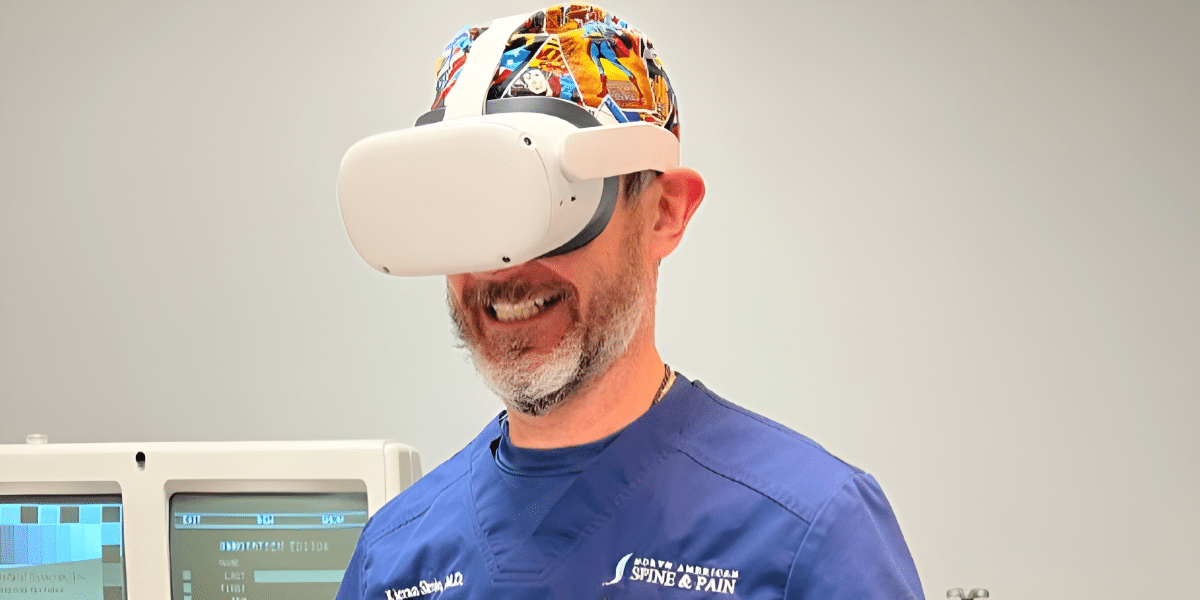As the leading physician at North American Spine and Pain, Dr. Kieran Slevin is always on the hunt for new and more effective ways to improve pain management – and to deliver a better, more rewarding patient experience. Dr. Selvin’s search for such improvements has fueled his interest in virtual reality (VR), a technology more widely available and with more applications than ever.
As Dr. Slevin has discovered, VR use is peaking, from education and training to gaming and other forms of entertainment. The technology combines cutting-edge hardware and software to create simulated user environments.
Industries like travel, tourism, and real estate increasingly utilize VR technology to encourage engagement and drive sales. The military, too, now relies heavily on the same tech for use in various exercises.
Yet, for Dr. Kieran Slevin, the use of technology in healthcare is of the utmost interest.
Irish-born Dr. Slevin is a physician and interventional spine specialist from Philadelphia County, Pennsylvania. Board-certified in anesthesiology and pain medicine, he co-founded a leading tri-state area spine and pain care provider and enjoys membership in the Pennsylvania Medical Society and the American Society of Anesthesiologists.
Dr. Slevin specializes in interventional pain management and developing clinical decision support for treatment algorithms. The following is a closer look at how VR is changing the pain management landscape across the U.S. and internationally, courtesy of the North American Spine and Pain co-founder and CEO.
Virtual Reality in Healthcare
VR has quickly established itself as an invaluable tool for healthcare professionals. Healthcare practitioners and researchers, in particular, now routinely utilize virtual reality technology in their work.
As Dr. Slevin knows, the world of medicine now relies heavily on VR for surgical training, while medical colleges and universities increasingly use the same tech in student tuition.
Virtual reality allows such institutions to place new and existing students in situations likely to arise in their subsequent medical careers. This form of immersive learning makes it an excellent tool for, for example, empathy training. The healthcare sector is also one of only a few that can comprehensively utilize the entire suite of VR hardware and software currently available.
That includes both semi-immersive and still-emerging fully immersive virtual reality in combination with more readily available non-immersive options. Semi-immersive VR is currently the most widespread in healthcare. This semi-immersive tech affords users massive educational and training value, particularly within healthcare and medicine.
Meanwhile, virtual reality is becoming an increasingly valuable tool for patients. Doctors now use VR to support patients dealing with disorders like anxiety. Elsewhere, physicians such as Dr. Kieran Slevin are frequently turning to pioneering innovations within virtual reality to transform the pain management landscapes of their patients.
VR for Pain Management
Virtual reality has rapidly established itself as a promising tool in pain management. Doctors and researchers are on the constant lookout for effective non-pharmacological methods of pain reduction away from opioids and other medicines. Entirely drug-free, the technology has shown itself effective in alleviating pain across numerous common clinical conditions.
VR, as a means of pain management, works by promoting sensory immersion. This sensory immersion limits attention to pain and reduces visual cues that may otherwise amplify them. Doctors and researchers have successfully used VR within medical environments to address injury-related physical pain, among other complaints.
Examples include musculoskeletal and post-surgical pain – two areas of particular focus for interventional spine specialist Dr. Kieran Slevin. He and fellow medical professionals studying VR-aided sensory immersion for pain management are also leveraging identical tech to combat the many visual cues amplifying conditions such as anxiety, particularly in medical settings.
Crucially, VR for pain management promotes almost complete patient autonomy. With that, individual patients can choose from a massive range of potential VR experiences. Whether fully immersive or not, each offers one or more unique experiences with the potential for distinctly different but invariably positive results concerning pain reduction.
Pain Management-Focused VR Experiences
Two excellent examples of virtual reality experiences tailored toward non-pharmacological pain management are beach relaxation and underwater swimming simulations. Here, sensory immersion and the combat of anxiety-centered visual cues serve in tandem to deliver significant relaxation responses.
During his research into this up-and-coming tech, Dr. Slevin has found studies showing that as little as 20 minutes of participation can deliver effective and highly satisfying results. Many participants report significant reductions in distress and anxiety coupled with lowered pain levels. Other positive outcomes include expressed satisfaction and broader stress and discomfort relief.
Simultaneously addressing distress, anxiety, and pain, such experiences delivered at hospital bedsides could prove highly valuable for patients experiencing acute pain. Elsewhere, it’s hoped that the same tech will benefit countless others in outpatient settings, including North American Spine and Pain patients.
Dr. Kieran Slevin and his team at the leading tri-state area spine and pain care provider see north of 150,000 patients annually. With over 120 staff, North American Spine and Pain have locations in Pennsylvania, Delaware, and New Jersey. Its team is wholly committed to setting the gold standard of care across Pennsylvania and surrounding areas.
Want to learn more? Visit Dr. Slevin and the North American Spine and Pain team today!
Published by: Martin De Juan

















